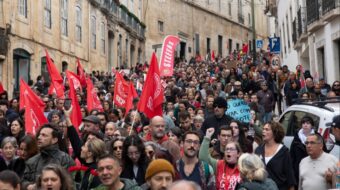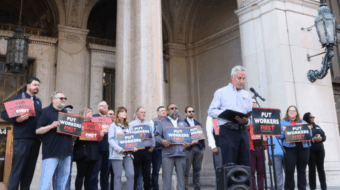NEW ORLEANS — It’s back to school time every fall all across America: you pack their lunches and send the kids off to school. Unless you live here.
Two years after Katrina tore through the mouth of the Mississippi, a New Orleans parent, after running an obstacle course that can take many months, is only sometimes able to place his or her child in a school.
As the Category 5 hurricane bore down, Gwen Kimbal, 47, cried as she loaded her car with clothing, her two children and a grandchild. She cried because she had to leave her mother, who had kidney disease, back at the hospital.
“I looked at my babies when I got in that car and I said to myself, ‘No Superdome for them,’ and I drove north for 10 hours, stopping only when the traffic didn’t let me move,” she said.
Gwen and her family slept on a friend’s floor in Little Rock, Ark. Two weeks into their stay they learned their house in the Lower 9th Ward had been washed away by the water that breached the levees, and in the third week they learned Gwen’s mom was among those who had died in hospitals without power, water, food, medicine or doctors.
Stacking things against you
For a few months Gwen’s young son Michael attended school in Little Rock. She decided to bring the family back to New Orleans because her skills as a painter and carpenter landed her a job and a small house in the Gentilly neighborhood. I talked to her there Oct. 18, shortly after she got home from work.
“Our economic well-being required that we come back, but they stack things against you,” she said. “They’ve made it almost impossible to get a child into a school.”
Chaos and privatization
Only five of the public schools open in the city are part of the New Orleans Public School System. In September 2006, each of the principals told Gwen that her son would have to remain home for anywhere from six months to a year.
“What kind of civilized society tells a working mother that there is no place for her child in a public school and that she could just as well keep him home?” Gwen asked.
There are 24 charter schools in the city, some federally funded and others run by private contractors. Gwen tried every single one. All had waiting lists, one with 300 names. It took from October 2006 through January 2007 to complete her fruitless search of the charter school system.
Finally, she decided to look into the 25 schools that are part of the “Recovery School District,” schools run by the state of Louisiana. She got Michael into one of them in March.
“Things were bad there last spring, but now they are a total and shameful disgrace,” she said. “There are 750 kids in the school and on some days not a single teacher shows up. They herd everyone into the gym or the auditorium for the whole day. There’s no homework, no education, no nothing going on there.
“I cry again every night because I see a future for my beautiful baby, my Michael, as a smart, strong healthy African American man and this system, placing no priority on education, sees his future in a prison cell,” Gwen said.
Planned disaster
Did it have to be this way? The woman with the answer and the union leader in the forefront of the battle for public education in New Orleans is Dr. Brenda Mitchell, president of United Teachers of New Orleans. I talked with her Oct. 19 after she addressed a group of labor journalists meeting in the city.
Her union had 4,700 members before the storm and represented teachers while it fought for good schools. On issues of class size, quality teaching materials and innovation in education, the union and the state education department were often at loggerheads, with community and parent groups seeing the union as their advocate too.
“The state superintendent of education told me two days after the storm that there would be no schools whatsoever in New Orleans for at least a year,” Mitchell said. “It was all about breaking the back of the union so they could break the schools, keep African American workers from coming home and set up a free-market reign of terror.
“Our membership went down to zero; they set up three chaotic systems and they brought in volunteers and inexperienced, uncertified teachers, creating a disaster.”
Teachers union rising
Mitchell and other union activists started to rebuild the union from scratch. They got support from teachers and parents in each of the three school systems and now have 1,125 members. They have, through the courts, forced the state to pay $7 million in grievances to teachers who were summarily dismissed after Katrina. They have won back sole collective bargaining rights in the five schools that are part of the official New Orleans public school system, and the schools where their numbers are strongest are showing some of the best academic results.
“It’s not just teachers, moving ahead,” Mitchell said. “The labor movement in this city is alive and well. Our union, the American Federation of Teachers, the AFL-CIO, the longshoremen, the pipefitters, the seafarers, the electrical workers — all of us are back. We’ve taken our unions back and we will take this city back.”
Mitchell said, “I’m tired of singing ‘We Shall Overcome,’ and I am definitely tired of crying. We’re fighting and we are going to win.”
jwojcik @pww.org









